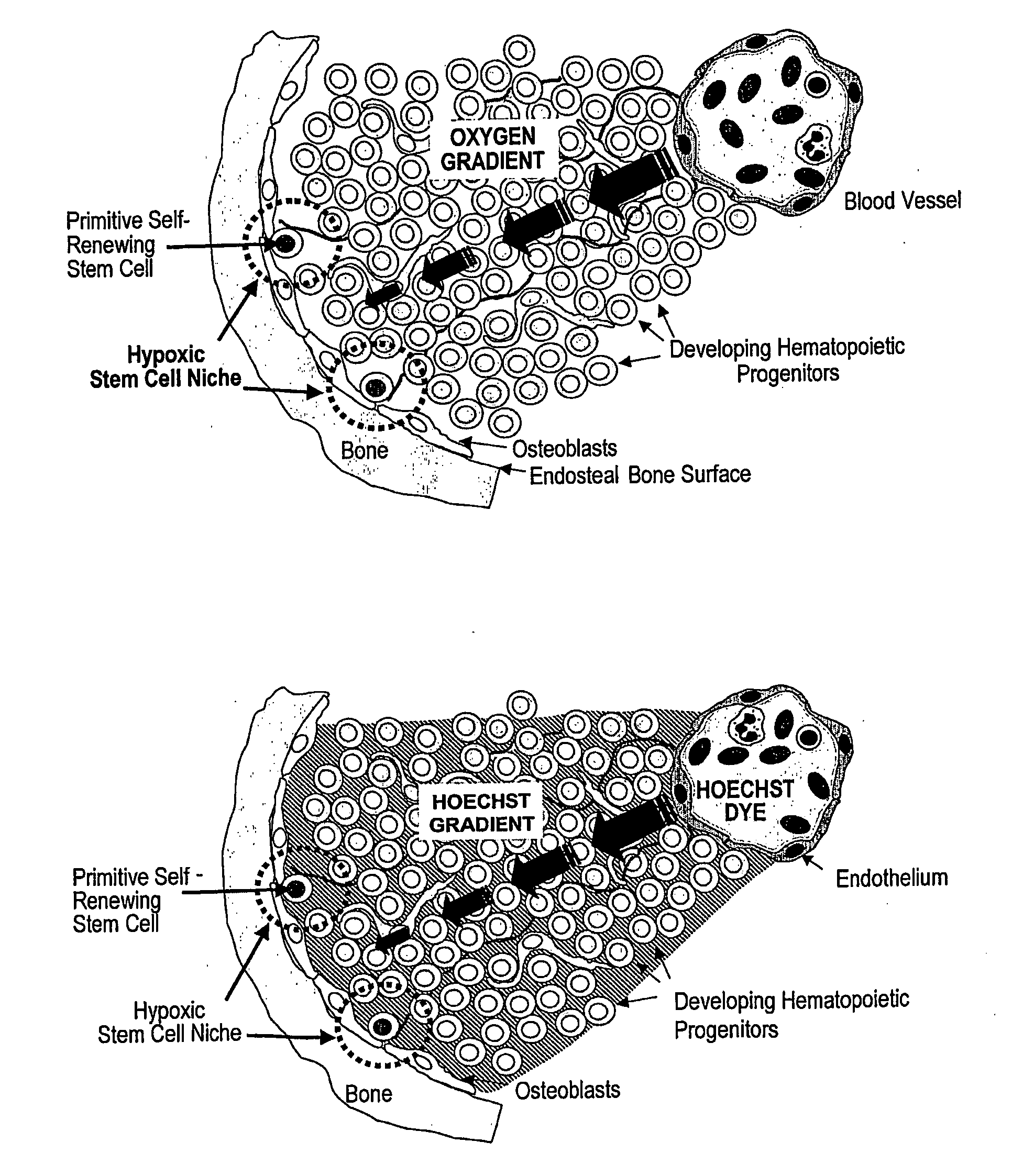Method for Selectively Depleting Hypoxic Cells
a technology of hypoxic cells and selective depletion, applied in the direction of immunological disorders, extracellular fluid disorders, antibody medical ingredients, etc., can solve the problems of difficult to target and eradicate cells, severe toxic side effects, clear drawbacks, etc., to prevent or reduce graft-versus-host disease, improve engraftment of donor stem cell transplants, and reduce toxicity
- Summary
- Abstract
- Description
- Claims
- Application Information
AI Technical Summary
Benefits of technology
Problems solved by technology
Method used
Image
Examples
example 1
Evidence That Different Hematopoietic Subsets Are Distributed Along a Hoechst Dye Perfusion Gradient That May Reflect the Distance from Blood Vessels and Level of Oxygenation
[0057]A number of previous animal studies have used the intravenous injection of the diffusible dye Hoechst 33342 to visualize tissue sections under fluorescence microscopy the perfusion of solid tumors in relation to hypoxia. Apart from situations in which tumor blood perfusion fluctuates leading to “acute” or “transient” hypoxia (Brown, 1979), most reports describe the location of hypoxic cells at a relatively constant from blood vessels (Bernsen et al., 2000; Chaplin et al., 1987; Durand et al., 1990; van Laarhoven et al., 2004) to indicate chronic or so diffusion-limited hypoxia, according to the classical model of Thomlinson and Gray (Thomlinson and Gray, 1955): Peggy Olive and colleagues have described an elegant series of experiments in which the Hoechst dye diffusion gradient can be more quantifiably cha...
example 2
Side Population (SP) Bone Marrow Cells Are Positive For a Hypoxic Cell Marker
[0062]In the present study, reductive 2-nitroimidazole compound pimonidazole was utilized, which, when administered in vivo, forms adducts in hypoxic regions (less than pO2 of 10 mm Hg) that can then be identified by anti-pimonidazole antibodies (FIG. 3).
[0063]To detect hypoxic cells in bone marrow and thymus, 120 mg / kg pimonidazole was administered i.p. to mice and bone marrow and thymocytes were harvested after 3 hrs post-injection. Bone marrow cells were stained with Hoechst 33342 in vitro and SP cells effluxing the dye (along with non-SP cells) were isolated by FACS. Thymocytes and sorted bone marrow populations were then fixed, permeabilized and incubated with the primary mouse anti-pimonidazole antibody (HypoxyProbe, Chemicon) and a goat anti-mouse secondary for staining and detection by flow cytometry.
[0064]The thymus was found to be very poorly perfused after Hoechst injection and, as expected, the ...
example 3
Selective Depletion of Late-Forming Cobblestone Area Forming Cell (CAFC) Subsets in Bone Marrow by Tirapazamine Treatment In Vivo
[0067]Several hypoxia-activated prodrugs have now been developed, among which the benzotriazine, Tirapazamine (TPZ), also known as SR4233, has been the most extensively studied and has therapeutic efficacy to the extent that it has now entered Phase II and III clinical trials in combination with radiotherapy and chemotherapy (Rischin et al., 2005; von Pawel et al., 2000). Under hypoxic conditions, TPZ is reduced to a benzotriazinyl radical and other reactive intermediates that ultimately leads to DNA double-strand breaks and cell death (FIG. 7). However, when oxygen is present, the TPZ radical is back-oxidized to the nontoxic parent compound (Brown and Wilson, 2004; Peters and Brown, 2002).
[0068]The present study therefore arose from the idea that HSCs might be rendered sensitive to TPZ treatments since many HSCs are hypoxic. Accordingly, age-matched (15-1...
PUM
| Property | Measurement | Unit |
|---|---|---|
| concentration | aaaaa | aaaaa |
| emission wavelengths | aaaaa | aaaaa |
| time | aaaaa | aaaaa |
Abstract
Description
Claims
Application Information
 Login to View More
Login to View More - R&D
- Intellectual Property
- Life Sciences
- Materials
- Tech Scout
- Unparalleled Data Quality
- Higher Quality Content
- 60% Fewer Hallucinations
Browse by: Latest US Patents, China's latest patents, Technical Efficacy Thesaurus, Application Domain, Technology Topic, Popular Technical Reports.
© 2025 PatSnap. All rights reserved.Legal|Privacy policy|Modern Slavery Act Transparency Statement|Sitemap|About US| Contact US: help@patsnap.com



